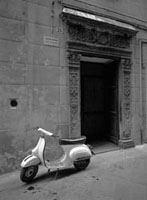Epson Stylus Photo 2200
Is It The Printer Photographers Have Been Waiting For
Not long after the new Epson
Stylus Photo 2200 was announced to the public photographers were obviously
in high anticipation because rumors of every dire kind began to circulate
about the printer when it did not appear in stores. But that was due
to Epson's schedule, which was right on target as the printer
for my test and evaluation was delivered on the day when I was told
it would. Now that I have worked with the new Stylus Photo 2200 I can
assure you the reasons for the high anticipation are sound and that
there seems to be no basis for the rumors. So what follows is an account
of my adventure to find out just what this new Epson printer can do. |
|||
Performance
features of the new 2200 are numerous and significant. The maximum resolution
for this printer is 2880x1440, which is not new, but with the Stylus Photo
2200 the maximum resolution may be used with all printing media, including
fiber matte papers. The Ultra Chrome inks have an estimated life of 40
years on RC-type papers and 80 on matte papers, and is currently being
tested independently by Wilhelm Imaging Research. These new inks are finer
milled pigments and yield the highest gamut for pigment ink media and
yield significant advances in image reproduction quality. For users of
the Epson Stylus Photo 2000P, the 2200's high printing speed, which
supports making an 8x10 photo print in under two minutes on Fine mode,
will be particularly significant.
All of this in a printer Epson estimates will sell on the street for $699 may sound too good to be true, but that is what the rest of my report is about, so keep reading. Print Testing The Epson
Stylus Photo 2200 |
|||
Being in one sense conventional,
and thinking of the RC-type papers like Premium Glossy as more of a work-type
commercial medium, I began my print testing with it as well as Premium
Semigloss and Premium Luster. I saved the fiber/matte papers like they
were dessert after the main course. Testing the three RC-type papers may
seem a fairly simple task, but there are a lot of variables to evaluate.
I wanted to see how the printer does with different kinds of images, some
very saturated, some neutral earth tones and which print driver setting
is best for portraits. I also was curious about printing black and white
photographs with this color printer. In addition to all the variables,
made possible by a number of print driver setting options, the new Stylus
Photo 2200 has yet another control, one to vary ink intensity. This would,
for instance, allow you to create a very pastel print of a high-key image
like a wedding portrait while preserving a normal coloration and relationship
of tones. |
|||
The Matte Finish |
|||
Later in my work I obtained
a professionally made color management profile for the Dotworks FHM paper,
as well as the sample sheets of Epson Velvet Fine Art paper. The custom
profile for the Dotworks FHM made a significant difference, further establishing
an advantage of this unique paper in producing richly colored images.
Evaluation And Recommendation |
|||
Printing Method: Epson
Micro Piezo ink jet technology |
- Log in or register to post comments







































